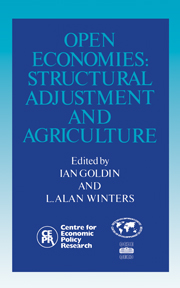Book contents
- Frontmatter
- Contents
- List of figures
- List of tables
- Preface
- Acknowledgements
- List of conference participants
- 1 Introduction: from macro to maize
- Part One Open economy analysis
- 2 Sequencing and welfare: labour markets and agriculture
- Discussion
- 3 Agricultural adjustment and the Mexico-USA free trade agreement
- Discussion
- 4 Do the benefits of fixed exchange rates outweigh their costs? The CFA Zone in Africa
- Discussion
- 5 Adjustment and the rural sector: a counterfactual analysis of Morocco
- Discussion
- Part Two The small country assumption and trade reform
- Part Three Risk and adjustment
- Part Four Government's role
- Index
5 - Adjustment and the rural sector: a counterfactual analysis of Morocco
from Part One - Open economy analysis
Published online by Cambridge University Press: 04 August 2010
- Frontmatter
- Contents
- List of figures
- List of tables
- Preface
- Acknowledgements
- List of conference participants
- 1 Introduction: from macro to maize
- Part One Open economy analysis
- 2 Sequencing and welfare: labour markets and agriculture
- Discussion
- 3 Agricultural adjustment and the Mexico-USA free trade agreement
- Discussion
- 4 Do the benefits of fixed exchange rates outweigh their costs? The CFA Zone in Africa
- Discussion
- 5 Adjustment and the rural sector: a counterfactual analysis of Morocco
- Discussion
- Part Two The small country assumption and trade reform
- Part Three Risk and adjustment
- Part Four Government's role
- Index
Summary
Introduction
Structural adjustment is usually seen as merely a macroeconomic problem because of its strong link to stabilisation which deals with the full restoration of internal as well as external equilibrium. But the aim of structural adjustment is larger: it is meant to place the economy on a new efficient path. These reforms will affect socioeconomic groups differently. Some groups may even block the adjustment process. In Morocco, for instance, three major upheavals of middle-class urban workers took place after the beginning of the adjustment period (in 1977), and succeeded twice in stopping the process. Political sustainability is obviously an important constraint on adjustment, but there also are good reasons to follow the fate of socioeconomic groups with less immediate political power. For adjustment to be objectively successful in the long run, it is important that no permanent damage be caused to human capital through an increase in absolute poverty and a worsening of health or education conditions in groups which, although politically weak, may in fact represent the majority of the population.
The present paper focuses on the effects of the adjustment process in Morocco upon rural workers and the agricultural sector. The former represent approximately 70 per cent of the labour force and they are responsible for 20 per cent of the GDP. In the perspective of adjustment, there are three reasons why this group may be important. First, it is clear from the previous figures that poverty largely concentrates in this group, and that it is there that the social cost of adjustment may be the heaviest.
- Type
- Chapter
- Information
- Open EconomiesStructural Adjustment and Agriculture, pp. 93 - 116Publisher: Cambridge University PressPrint publication year: 1992
- 1
- Cited by



